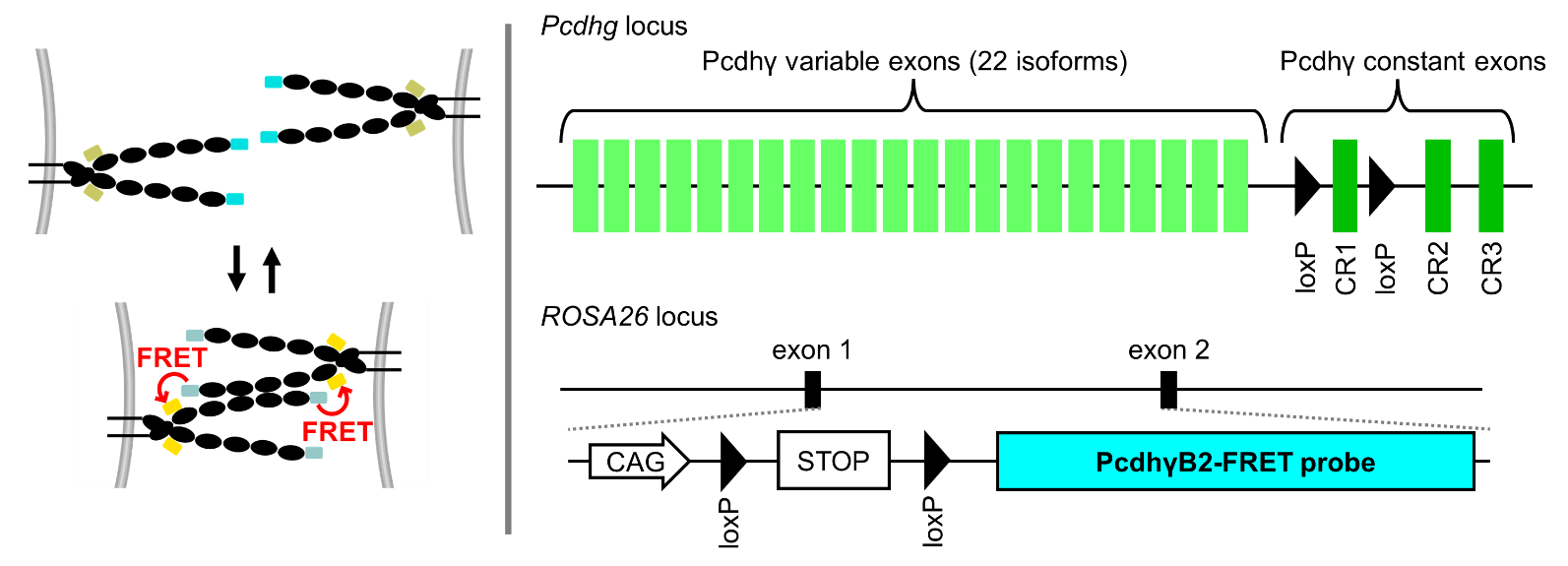 |
March 2024 Mouse of the Month |
|
Visualization of trans homophilic interactions B6;TT2-Pcdhg <tm(floxed neo)Tyag > Tg(Gt(ROSA)26Sor-CAG-PcdhgB2-FRET)#Tyag/TyagRbrc (RBRC11902)
|
|
| Clustered protocadherin (Pcdh) is a group of single transmembrane proteins expressed in the central nervous system. It is known that the mouse has 58 Pcdh isoforms and that some isoforms are expressed stochastically and selectively in individual neurons. It has been suggested that Pcdh acts as a cell recognition molecule and exhibits trans homophilic interactions in cell-membrane interactions, where only the same isoforms interact with each other. The mouse strain introduced here (RBRC11902) is capable of imaging Pcdh homophilic interactions using a newly developed Förster resonance energy transfer (FRET) probe. In the Pcdh γB2 FRET probe, two fluorescent proteins (CFP and YFP) are inserted into the PcdhγB2 isoform. Only when the PcdhγB2 homophilic interaction occurs, CFP and YFP come close to each other, and when CFP is excited, we observe how much energy is transferred from CFP to YFP. Furthermore, the expression of both the endogenous Pcdhγ isoforms and the transgenic PcdhγB2-FRET probe are conditionally regulated in this strain. In the presence of Cre recombinase, the endogenous Pcdhγ genes that consist of 22 isoforms are knocked out and the PcdhγB2-FRET probe is overexpressed. The development of this strain will allow the observation of Pcdh homophilic interactions, which is expected to provide a clue for further understanding of neuronal activity. Furthermore, as the Pcdh gene has been reported to be involved in autism and schizophrenia, this strain is expected to lead to a new understanding of these diseases. |
| Keywords | : | protocadherin(Pcdh), FRET, homophilic interaction, neuron, Cre/loxP system | |
| Depositor | : | Takeshi Yagi, Ph.D. (Osaka University) | |
| Strain name | : | B6;TT2-Pcdhg <tm(floxed neo)Tyag > Tg(Gt(ROSA)26Sor-CAG-PcdhgB2-FRET)#Tyag/TyagRbrc | |
| RBRC No. | : | RBRC11902 | |
| Reference | : | [1] | Hoshino N, Kanadome T, Takasugi T, Itoh M, Kaneko R, Inoue YU, Inoue T, Hirabayashi T, Watanabe M, Matsuda T, Nagai T, Tarusawa E, Yagi T. Visualization of trans homophilic interaction of clustered protocadherin in neurons. Proc Natl Acad Sci U S A. 2023 Sep 19;120(38):e2301003120. |
| Related mouse resource | : | B6;TT2-Pcdhg(floxed neo) (RBRC02800) | |
| March 2024 Saori Mizuno, Ph.D. Contact: Experimental Animal Division, RIKEN BioResource Research Center (animal.brc@riken.jp) All materials contained on this site may not be reproduced, distributed, displayed, published or broadcast without the prior permission of the owner of that content. |





